 ... a working model
... a working model
Your lungs pull in air about 30 times every minute, and push it out just as often, all without you really thinking about it. They do a lot of work. How do they do what they do?
We're going to show you how to build a working model of your lungs, so you can see for yourself!
You will need a large clear plastic pop bottle, a garbage bag, some scissors, duct tape, two straws, two balloons, a lump of plasticine, and a small piece of thin cardboard.
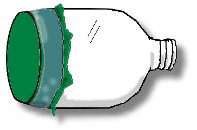
The first step is to cut off and discard the bottom half of the pop bottle. Cut out a piece of plastic from the garbage bag, and tape it loosely but securely to the opening on the top half of the bottle. Make sure the plastic is attached well; it must make an airtight seal. The plastic should be loose and floppy in the center.
 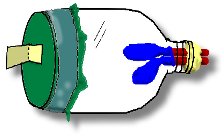
Wrap the lump of plasticine carefully around the two straws so they make an airtight seal. Attach two balloons to the straws as shown; tape them on securely. Then wedge the lump into the bottle top, sealing it carefully again.
Now attach the piece of cardboard to the plastic bag with some duct tape.
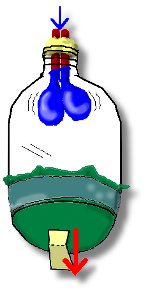 O.K., we're all done. Here's how it works. The bottle represents your chest, with the neck at the top and the lungs inside. O.K., we're all done. Here's how it works. The bottle represents your chest, with the neck at the top and the lungs inside.
The bag at the bottom represents your diaphragm, a flat tissue that moves up and down as muscles contract and expand. When your muscles pull it down, (simulated by pulling down on the cardboard), the chest cavity becomes larger, and the air pressure lowers. This causes your lungs to expand, all by themselves, just as the balloons will, as they fill with outside air.
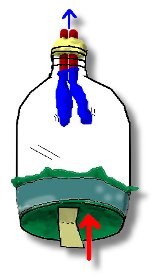
Now push up on the cardboard. This causes the chest cavity to decrease in size, and the air pressure inside the chest to rise. This squeezes the lungs, forcing the air up and out.
In your body, the muscles which cause the diaphragm to move up and down are controlled automatically by your nervous system; you don't have to think about it.
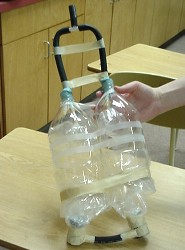
Here is a photo of a model pair of lungs made Cody C., a student at Worsley School. It includes both lungs, and uses clear plastic bags for the diaphragm and lung sacs. The expansion and contraction of the lungs as the diaphragm moves down and up is clearly visible.
You might like to visit our Science Lab, where you can do a simple experiment, that will let you measure the strength of your own lungs.
|
Resources
|